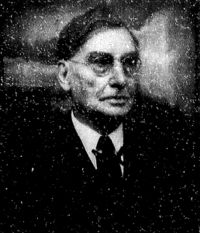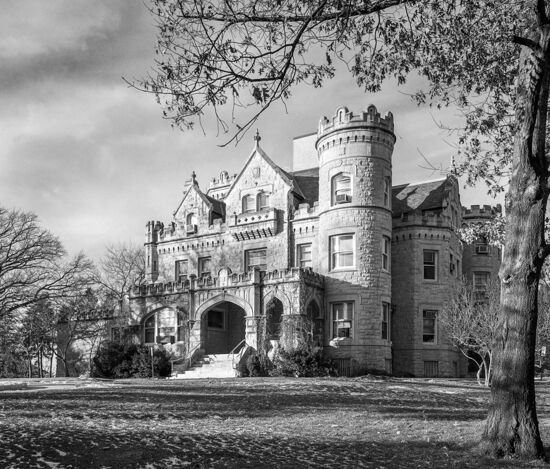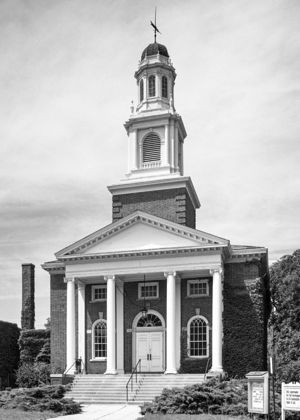John McDonald (1861-1956), Architect
John "Jack" McDonald was born April 22, 1861 in Prince Edward Island, Canada. He was the son of Mr. & Mrs. Angus McDonald and second born of eleven children. The McDonalds are a family of Scottish heritage. John received his education in civil engineering in Canada, earning his Bachelor of Science from McGill University in 1884. McDonald moved to Omaha after graduation, quickly finding work as a partner in a local firm.[a] It did not, however, take him long to open his own architectural firm, where he was joined by classmate and friend David Ogilvy. Ogilvy left Omaha by the late 1880s, and McDonald married his wife Martha Tibbitts in 1890. His split with Ogilvy did not hurt him professionally, and business prospered in the rapidly developing city of Omaha.
McDonald's close friend, George Joslyn, hired John at only 30 years old to develop his estate. His association with the name Joslyn granted McDonald access to other big-name clients and popularity. The personal friendship between the Joslyns and McDonalds was valuable as well.[12:46] In 1917, John established a partnership with his son, Alan McDonald, which lasted until Alan's death in 1947. John is recognized for 66 years of noteworthy contributions to the city of Omaha. He died on May 7, 1956, and is interred in Forest Lawn Memorial Park in Omaha. John believed personally that buildings should last forever, and because of this, many of his buildings are still standing and active today.[7][10][12:13]
This page is a contribution to the publication, Place Makers of Nebraska: The Architects. See the format and content page for more information on the compilation and page organization.
Contents
Compiled Nebraska Directory Listings
Omaha, Nebraska, 1892-1950, 1953-1954
Educational & Professional Associations
1868-1880: Private, grammar, and normal schools, Prince Edward Island, Canada.[7][12:1]
1881-1884: Bachelor of Science, Civil Engineering, McGill University, Montreal, Canada.[7]
1885-1886: partner, Sidney Smith, Architect, Omaha, Nebraska.[7]
1887-1891: partner, McDonald & Ogilvy, Architects, Omaha, Nebraska and Portland, Oregon.[7]
1892-1917: John McDonald, Architect, Omaha, Nebraska.[7]
1917-1946: partner, John & Alan McDonald, Architects, Omaha, Nebraska.[7]
1938: Registered Professional Architect, Nebraska, February 15, 1938; A-46.[7]
1949-1955: John McDonald, Architect, 604 Standard Oil Building, Omaha, Nebraska.[a]
Other Associations
1901: employed F. William Krelle, draftsman.
1906: employed Max Nippell, draftsman.
1908-1910: employed Arthur Dixon Baker, draftsman.
Buildings & Projects
1880s
The Barker Building (ca. 1886), SW corner of 15th & Farnam St., Omaha, Nebraska.[12:61][e]
Apartments (1887), 1313-1315 & 1317-1319 S. 32nd St., Omaha, Nebraska.[12:10]
Apartments (1888), 1146 South 32nd St., Omaha, Nebraska.[12:10]
J. H. Loomis House (1888), 1920 Wirt, Omaha, Nebraska.[3:178][5] (DO09:0140-057)
House (1888), 1142 S. 32nd St., Omaha, Nebraska.[12:9]
Apartments (1888), 1124 and 1126 S. 31st St., Omaha, Nebraska.[12:9]
Apartments (1888), 1719 Park Ave. overlooking Hanscom Park, Omaha, Nebraska.[12:9]
1890s
House (1890), 1338 S. 31st St., Omaha, Nebraska.[5][12:9] (DO09:0204-108)
House for John McDonald (1891), 1334 S 31st St, Omaha, Nebraska.[3:83][5][12:6] (DO09:0204-107)
House (1891), 1335 S. 30th Ave., Omaha, Nebraska.[5] (DO09:0204-123)
House (1891), 1120 Park Ave., Omaha.[5][12:8] (DO09:0203-009)
George A. & Sarah Joslyn Estate aka Joslyn Castle (1892-1903), 3902 Davenport St., Omaha, Nebraska.[3:113][4][5][12:14] (DO09:0321-001) National Register narrative
G. William Carlock House (1896), 1314 S 30th Ave., Omaha, Nebraska.[3:78][5] (DO09:0204-115)
House (1897), 3102 Woolworth Ave., Omaha, Nebraska.[5][8] (DO09:0204-136)
House (1897), 3104 Woolworth Ave., Omaha, Nebraska.[5] (DO09:0204-135)
House (1897), 3106 Woolworth Ave., Omaha, Nebraska.[5] (DO09:0204-134)
Williams-Bostwick House (1892-1898-191?), 3716-22 Dewey Ave., Omaha, Nebraska.[4][5] (DO09:0319-012)
Nebraska Building (1898), Trans-Mississippi and International Exposition, Omaha, Nebraska.[1:160][12:15][b]
Apiary Building (1898), Trans-Mississippi and International Exposition, Omaha, Nebraska.[1:132][2][12:16]
1900s
First Baptist Church (1901), Park Ave. & Harney St., Omaha, Nebraska.[12:11]
Flat (1904), 2552 Harney St., Omaha, Nebraska.[5] (DO09:0209-040)
Dr. Paul Grossman Town Houses (1904), 102-108 S. 36th, Omaha, Nebraska.[5][12:36] (DO09:0319-002)
F.E. Pearce House (1904), 119 S. 37th, Omaha, Nebraska.[5] (DO09:0319-062)
First Christian Church (1905), 26th & Harney St., Omaha, Nebraska.[12:10]
House for Mrs. Horbach (1905), 120 N. 32nd St., Omaha.[5][12:44] (DO09:0212-058)
Charles D. McLaughlin House (1905), 507 S. 38th St., Omaha, Nebraska.[4][5] (DO09:0317-004) National Register narrative
Frank Blish House (1905), 117 S. 37th, Omaha, Nebraska.[5] (DO09:0319-061)
Harry P. Whitmore House (1906), 3905 Dewey Ave., Omaha, Nebraska.[4][5][12:37] (DO09:0317-015)
Alex G. Buchanan House (1906), 1330 Turner Blvd, Omaha, Nebraska.[3:174][5] (DO09:0204-077)
L.L. Black House (1906), 3808 Harney, Omaha, Nebraska.[4][5] (DO09:0319-047)
Brandeis Commercial Building (1906), 1012-1014 S. 10th, Omaha, Nebraska.[4][5] (DO09:0119-017)
House for Fred Squires Knapp (1906), 1330 S. 35th St., Omaha, Nebraska.[12:29]
W. A. DeBord House (1907), 3520 Woolworth Ave, Omaha, Nebraska.[3:182][5] (DO09:0204-063)
F. Knapp House (1907), 1330 S. 35th St., Omaha, Nebraska.[3:97][5] (DO09:0204-065)
House for Mr. DeBord (1907), 3520 Woolworth Avenue, Omaha, Nebraska.[12:28]
House for Mr. & Mrs. John Webster Towle (1907-1908), 3602 Pacific St., Omaha, Nebraska.[12:27]
J.W. Thomas House (1908), 3820 Harney, Omaha, Nebraska.[4][5] (DO09:0319-050)
House for G. Day (1908), 1310 Turner Blvd, Omaha, Nebraska.[3:173][5][12:29] (DO09:0204-073)
House (1908) 1330 Turner Blvd., Omaha, Nebraska.[12:26]
House (1908) 3303 Woolworth Ave., Omaha, Nebraska.[12:26]
House (1909), 2202 Hanscom Blvd, Omaha, Nebraska.[3:129][5][12:26] (DO09:0200-027)
House for H. Fish (1909), 3311 Woolworth Ave, Omaha, Nebraska.[3:181][5][12:28] (DO09:0202-036)
George H. Thummel House (1909), 404 S. 38th St., Omaha, Nebraska.[4][5] (DO09:0319-015)
Porter-Phalen House (1909), 444 N. 38th St., Omaha, Nebraska.[5][12:41] (DO09:0323-017)
Omaha Printing Company (ca. 1909), 13th & Farnam St., Omaha, Nebraska.[12:69]
1910s
Bradford-Pettis house (1910), 404 S 39th St., Omaha, Nebraska.[3:101][4][5][12:35] (DO09:0319-008) National Register narrative
Rowhouse (1910), 3040-42 Cass St., Omaha. Nebraska.[5] (DO09:0214-015)
Commercial Building (1910), 3928 Farnam, Omaha, Nebraska.[5] (DO09:0319-046)
Arthur English/J.A.C. Kennedy House (1910-1911), 521 N. 38th St., Omaha, Nebraska.[5][8][12:38] (DO09:0323-011)
Building (1911), 601 N. 16th St., Omaha, Nebraska.[5] (DO09:0127-017)
John & Martha McDonald House (1911), 515 N. 38th St., Omaha, Nebraska.[5][8][12:39] (DO09:0323-012)
Barton Millard House (1911), 3650 Burt St., Omaha, Nebraska.[12:42]
The Child Saving Institute (1912), 619 S. 42nd St., Omaha, Nebraska.[12:57]
Drummund Motor Company Building (1912), 2570 Farnam St., Omaha, Nebraska.[5] (DO09:0209-015)
House (1912), 130 N. 39th St., Omaha, Nebraska.[5] (DO09:0321-024)
The Joslin Memorial Library (1913), Waitsfield, Vermont.[12:58][d]
Mrs. Martha A. Fitzgerald House (1913), 113 S. 38th St., Omaha, Nebraska.[5] (DO09:0407-026)
Beebe & Runyon Furniture Showroom & Warehouse (1913), 105 S 9th St., Omaha, Nebraska.[3:41][4][5][12:67] (DO09:0068-001) National Register narrative
Commercial Building (1913), 1416 Howard St., Omaha, Nebraska.[5] (DO09:0121-041)
Benjamin F. Marshall House (1913), 3646 Burt St., Omaha, Nebraska.[5][12:42] (DO09:0325-018)
W.L. Coakley House (1913), 204 S. 37th St., Omaha, Nebraska.[5] (DO09:0319-037)
Forrest Lawn Memorial Park Chapel & Crematory (1913), 7909 Mormon Bridge Road, Omaha, Nebraska.[9][12:81]
Keen Hotel major Remodel (1914), 18th & Harney St., Omaha, Nebraska.[12:72]
Oblate House (1915), Creighton University, 2104 Davenport, Omaha, Nebraska.[3:112][5] (DO09:0126-013)
Commercial Building (1915), 2401 Farnam St., Omaha, Nebraska.[5] (DO09:0209-045)
The Creighton Working Girls' Home (ca. 1915), 22nd & Davenport St., Omaha, Nebraska.[12:71]
John Bachelor House (1916), 525 Main, Valentine, Nebraska. (CE14-082)
Muse Theater (1916), 2405 Farnam St., Omaha, Nebraska.[5] (DO09:0209-044)
Western Newspaper Union Building (1916), 621 S. 15th, Omaha, Nebraska.[4][5][12:62] (DO09:0121-069)
Henry Yates Elementary School (1916-1917), 3252 Davenport, Omaha, Nebraska.[3:112][5][12:77] (DO09:0212-002)
Mid-America Youth Foundation Center (1917), 513 S. 15th St., Omaha, Nebraska.[5] (DO09:0121-056)
The Shafer Building (now Creighton U. campus building) (1917), 701 N. 17th St., Omaha, Nebraska.[12:63]
Home (1917), 5202 Burt St., Omaha, Nebraska.[9:95]
Commercial Building (1917), 1712 Jackson St., Omaha, Nebraska.[5] (DO09:0122-040)
First Unitarian Church (1917-1918), 3114 Harney, Omaha, Nebraska.[3:132][4][5][12:27] National Register narrative
Regis Hotel (1918), 312 S. 16th St., Omaha, Nebraska.[5] (DO09:0124-043)
The Tadousac Apartments (1919) 418 S. 38th St., Omaha, Nebraska.[4][5][12:34,36][c] (DO09:0319-014)
1920s-1950s
Bungalow (ca. 1920), 1014 S. 36th St., Omaha, Nebraska.[12:29]
The Faidley Building (1920), 1514 Douglas, Omaha, Nebraska.[3:116][5][12:75] (DO09:0123-035)
DeWitt K. Ellingwood House (1921), 3647 California St., Omaha, Nebraska.[5][12:44] (DO09:0323-013)
Building (1923), 705 S. 12th St., Omaha, Nebraska.[5] (DO09:0121-083)
Children’s Museum (1924), 551 S. 18th St., Omaha, Nebraska.[5] (DO09:0122-038)
Dr. J. F. Langdon House (1928), 503 N. 38th St., Omaha, Nebraska.[12:42]
Garage (1938), 1763 Jackson St., Omaha, Nebraska.[5] (DO09:0122-063)
Fairmont Creamery Addition & Garage (1940), 1101 Jones, Omaha, Nebraska.[4][12:73] (DO09:0121-093)
Brodkey’s (1946), 1524 Harney St., Omaha, Nebraska.[5] (DO09:0123-079)
Undated
E.W. Gunther House (n.d.), 320 N. 40th St., Omaha, Nebraska.[12:43]
House (n.d.), 405 N. 40th St., Omaha, Nebraska.[12:43]
Omaha Community Playhouse (n.d.), 40th & Davenport St., Omaha, Nebraska.[12:43]
E. A. Mills House (n.d.), 120 N 39th St., Omaha, Nebraska.[12:44]
Iten Biscuit Company-Snow White Bakery (n.d.), 12th & Capitol St., Omaha, Nebraska.[12:68]
Phalen-Shirley Building (n.d.), SW corner of 24th & Farnam St., Omaha, Nebraska.[12:70]
The Muse Theatre (n.d.), 2405 Farnam St., Omaha, Nebraska.[12:70]
Honors & Awards
Omaha Chamber of Commerce Recognition for 66 years of service. [12:107]
Notes
a. Last Omaha directory listing, 1955. In the business section of the 1954 and 1955 directories, McDonald is listed as John T. McDonald; it is not known if this represents his middle initial, or if it was a typographical error. He is not known to have otherwise used a middle initial.
b. The Nebraska Building was a joint project of James H. Craddock, Lincoln, and John McDonald.[1:160]
c. The Tadousac is named for a historic hotel in a 400-year old resort in John's "native" Quebec, Canada.[12:34]
d. The Joslin Memorial Library is the only known building John McDonald built outside of the state of Nebraska. It is still in use today.[12:58]
e. Reference credits the Barker Building to John McDonald, but states that at the time of construction, the name of the firm was still [Ogilvy & McDonald]. The building caught fire when at near completion, and was rebuilt in cast iron.[12:61]
References
1. James B. Haynes, History of the Trans-Mississippi and International Exposition of 1898 ([Omaha]: Committee on History, 1910).
2. “Trans-Mississippi and International Exposition,” Omaha Public Library Website, 1998. Images accessed July 7, 2003, <http://www.omaha.lib.ne.us/transmiss/buildings/apiary.html>
3. Landmarks, Inc., An Inventory of Historic Omaha Buildings (Omaha: Landmarks Heritage Preservation Commission, 1980).
4. Listed in the National Register of Historic Places.
5. City of Omaha Planning Department, Landmarks Heritage Preservation Commission, Database, Query on Architects, May 20, 2002; courtesy of Lynn Meyer, Preservation Planner.
6. AIA Historical Directory of American Architects: A Resource Guide to Finding Information About Past Architects, accessed June 1, 2010, http://communities.aia.org/sites/hdoaa/wiki/Wiki%20Pages/ahd1029358.aspx
7. Application for Registration to Practice Professional Engineering and Architecture, Nebraska State Board of Examiners for Professional Engineers and Architects, December 30, 1937. Nebraska State Historical Society RG081 SG2.
8. Erin Grace, “Homeowners Cherish and Preserve Their Link to Omaha’s Past,” Omaha World Herald (January 28, 2014), 1B-2B.
9. The Cemetery Handbook (Chicago: Allied Arts Publishing Co., ca. 1920), 184-187.
10. "John McDonald," Find A Grave Memorial # 146327972, May 11, 2015. Find A Grave.com Accessed July 27, 2016. http://www.findagrave.com/cgi-bin/fg.cgi?page=gr&GRid=146327972&ref=acom
11. “McDonald, Alan,” Who's Who in Nebraska. Lincoln: Nebraska Press Association (1928), 129.
12. Joan M. Fogarty, Building Omaha: The Architectural Legacy of John and Alan McDonald (Omaha: Elman Printing Company, 2013).
Page Citation
D. Murphy, “John McDonald (1861-1956), Architect,” in David Murphy, Edward F. Zimmer, and Lynn Meyer, comps. Place Makers of Nebraska: The Architects. Lincoln: Nebraska State Historical Society, July 27, 2016. http://www.e-nebraskahistory.org/index.php?title=Place_Makers_of_Nebraska:_The_Architects Accessed, May 18, 2024.
Contact the Nebraska State Historic Preservation Office with questions or comments concerning this page, including any problems you may have with broken links (see, however, the Disclaimers link at the bottom of this page). Please provide the URL to this page with your inquiry.


